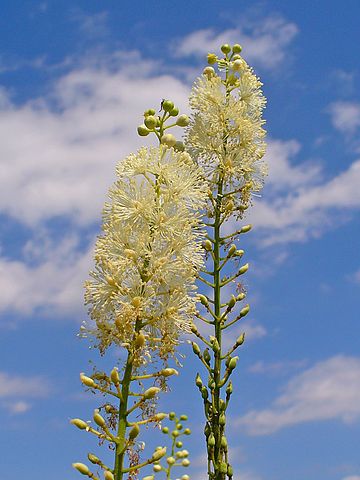See Part 1 here. Black cohosh has long been used throughout the world, but today its many uses have been mostly forgotten in the face of its powerful effects on menopause. Here are many more of its traditional uses that expand its effectiveness far beyond menopause. Native American women have long used black cohosh to relieve childbirth pains (it stimulates uterine contractions during labor), afterbirth pains and menstrual pain. To facilitate childbirth, combine with raspberry leaves and blue cohosh, and take daily for the last two weeks of pregnancy. If needed, it may be used in the last trimester of pregnancy to relax spasmodic uterine activity (combine with black haw and wild yam). The Native Americans also used black cohosh for rheumatism and arthritis. According to Steven Foster, the Oklahoma Delaware used black cohosh with elecampane and stoneroot (probably Collinsonia canadensis) together as a general tonic for the body while the Iroquois used it to promote lactation and treat rheumatism and babies’ sore backs. The Cherokee also used black cohosh for rheumatism as well as a tonic, diuretic, anodyne, and emmenagogue to treat colds, cough, consumption, constipation, fatigue, hives, backache, and help babies sleep. Further, the northeastern Algonquians used it for kidney troubles. The Eclectic herbalists used it similarly to treat menstrual disorders, childbirth preparation, and rheumatism (once called “rheumatism week”), and yet they also employed it as a wonderful antispasmodic and nervine for arthritic disorders, including rheumatoid arthritis, osteoarthritis, joint inflammation, muscle problems, lumbago, stiff neck, cramps, nerve pains, tics, convulsions, epilepsy, and nervous excitability. It’s long been used in Europe for all of these conditions as well. Overall, black cohosh treats pain characterized by tension and a dragging sensation. Consider it good for achy muscle and nerve pains, especially if there’s a bearing-down sensation. It is also used for unpleasant sensations in the uterus during the last months of pregnancy and false pains. I have successfully used black cohosh with white peony to treat epilepsy, lessening the frequency and severity of seizures. In more recent times, Dr. Christopher has used it with lung herbs to ease whooping cough, asthma and bronchitis (supposedly it helps dilate the bronchioles). While Chinese herbalists use a different species of black cohosh, C. foetida, it is used somewhat similarly. Mainly known as a cooling diaphoretic, it treats the initial stages of colds, flu, fever, headache, and sore throat. As well, it treats swollen or painful gums, ulcerated lips or gums, canker sores, toothache, and bad breath. It also ripens and brings out skin rashes such as measles in their early stages. The Chinese also consider black cohosh an important herb to raise the Yang and lift sunken Qi with symptoms of shortness of breath, mood swings, fatigue and prolapsed stomach, intestines, bladder, uterus, rectum, or veins. While we don’t know if the different uses of the Western and Chinese species of black cohosh is due to their constituents or to different traditions, there is enough similarity in both that either tradition can benefit from the experience of the other and expand our use of this important herb. The Chinese could expand their use to rheumatism and menopausal symptoms while Western herbalists could use it for colds and flu along with their accompanying symptoms, ripening early rashes, and for prolapse. Since Western black cohosh already “lifts the spirits” in terms of treating menopausal mood swings, it could well have this raising effect on the organs. Dose: Decoct 1 tsp. dried root/1 cup water, take 2-3 cups/day; 2 “00” caps 3 times/day; tincture, 10-40 drops, 1-4 times/day; 3-9 g in formulas; prepare C. foetida with wine or stir-fry to increase its ascending action; stir-fry with honey to nourish the lungs and relieve cough. Precaution: Higher than recommended doses causes nausea, dizziness, vomiting, light headedness, headaches, low blood pressure, dilated pupils and dimness of vision; Yin Deficiency with Heat signs, fully erupted measles, in those with breathing difficulty and in those with excess above and deficiency below. Biochemical constituents: Various glycosides such as triterpine and actein, salicylic acid, ferulic acid, woferulic acid, cimicifugoside, formononelin, bitter principles, racemosin, triterpenes, isoferulic acid, salicylic acid, tannin.

